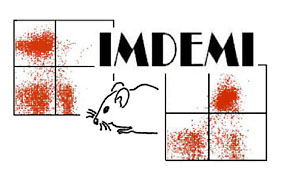A. Genetic modification of the mouse
genome
A series of new mouse models are generated modified in genes with complex key roles in a variety of
immune functions displayed by different cell types of the immune system. Genetically modified mouse models
are indispensable for defining the biological function of these genes and their involvement in diseases.
Several measures are taken to improve the procedures:
- Gene targeting is performed in ES cells derived from the C57Bl6 inbred
strain, the major model mouse strain in immunology, thus avoiding 2 years back
crossing.
- To shorten the time required for the construction of targeting vectors
and to enable modification of large BAC vectors very efficient recently improved homologous recombination
systems in bacteria are used.
- Transgenic mice with inducible expression systems are based on the most
advanced versions of tamoxifen inducible ERT and doxycyclin inducible tTA and rtTA expanded with other
hormone inducible systems e.g. CrePR
- To enhance the frequency of transgenic mice with the expected
expression profile both ERT2 / Pr and (r)tTA/TetO transgenic mice are generated either by making a
'knock in' in the gene with the desirable expression profile or by cloning the inducible gene into
a BAC vector used for oocyte injections.
- Cell lineage specific Cre transgenic mice are generated for the
generation of cell type specific (conditional) KOs
- In case homologous recombination in ES cells cannot be applied
to target a particular gene RNAi will be applied as an alternative.
B. Analysis of the phenotype and application in disease
models
A wide variety of methodologies is available and applied throughout the project. All the work is based on the use of immune deficient animals combined with established mouse models of (human) diseases.
Phenotypic analysis
For phenotypic analysis a variety of standard techniques and detection methods is available within all
laboratories of the network extended with many special techniques operational in one or more participating laboratories.
Standard techniques: FACS staining, cell sorting by FACS and magnetic beads (MACS), cell proliferation assays,
cytotoxicity assays, cytokine assays, ELISA ((e.g. complement activity), in vitro an in vivo phagocytosis assay,
serological analysis of autoantibodies, histopathology, immuohistochemistry, fungal and bacterial infection studies.
Special techniques: In vivo imaging: bioluminescence of luciferin; in situ hybridisation of the immune response,
assessment of renal injuries, clearance of apoptotic cells in vivo and in vitro, CSFE staining and adoptive transfer,
rozetting assay, in vivo complement depletion by CVF, in vivo cell depletion by monoclonal antibodies
against B cells, T cells and neutrophils, in vivo immune complex clearance, in vivo and
in vitro antigen presentation assays, culture of primary cells such as neurons and keratinocytes, confocal imaging of living cells, gene expression profiling using microarrays.
Disease models
The following disease models are established within the network:
- several variants of arthritis,
- glomerulonephritis,
- experimental allergic encephalomyelitis (EAE, a model for multiple sclerosis)
- atherosclerosis,
- SLE,
- psoriasis-like skin inflammation
- gut inflammation (mouse models for inflammatory bowel disease),
- chronic granulomatous disease,
- aspergillosis, candidiasis,
- bacteraemia,
- Diabetes type I & type II,
- lymphocyte and phagocyte hyperresponsiveness,
- a large variety of bacterial infections: Salmonella, S. pneumoniae,
M. tuberculosis, specific intestinal infections etc.
- Endotoxic shock (LPS/SEB)
|

